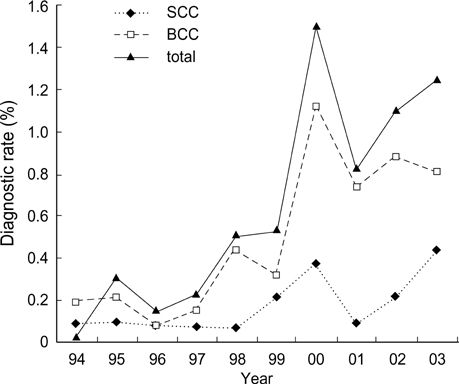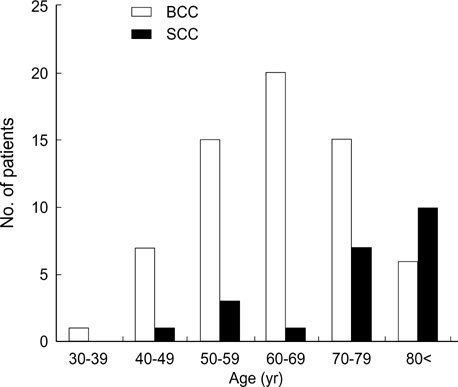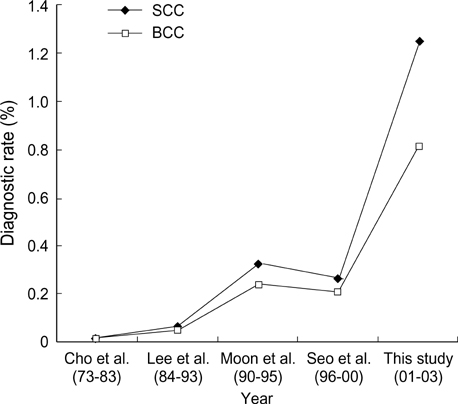J Korean Med Sci.
2005 Apr;20(2):279-282. 10.3346/jkms.2005.20.2.279.
Primary Facial Skin Cancer: Clinical Characteristics and Surgical Outcome in Chungbuk Province, Korea
- Affiliations
-
- 1Department of Otolaryngology, College of Medicine, Chungbuk National University, Cheongju, Korea. hrjin@chungbuk.ac.kr
- 2Department of Dermatology, College of Medicine, Chungbuk National University, Cheongju, Korea.
- KMID: 1095204
- DOI: http://doi.org/10.3346/jkms.2005.20.2.279
Abstract
- Clinical features of facial skin cancer in Asian population including Korean are not readily available. In the present study, we analyzed the clinical characteristics and the surgical results of primary facial skin cancer in Chungbuk Province, Korea. Eighty-six cases of primary facial skin cancer collected during a 10-yr period (1994-2003) were retrospectively reviewed about the clinical characteristics including age, sex, annual diagnostic rate, types of tumor, specific sites of occurrence, and the surgical results. The average age at the diagnosis was 67 and male to female ratio was 1 to 1.05. The average annual diagnostic rate was 0.73% and the rate surged during the period 2001-2003 compared with the period 1994 to 2000. Basal cell carcinoma was the most common tumor and the nose was the most frequent site. Traditional surgical excision with immediate reconstruction was performed in 81 cases. During the 23 months of average follow-up, three patients had recurrences (3.7%) and three patients had secondary skin cancers. Facial skin cancer is increasing in the province and basal cell carcinoma is most frequent. Traditional surgical excision and immediate reconstruction with local flap are a good therapeutic modality with an acceptable recurrence rate.
MeSH Terms
Figure
Reference
-
1. Buzzell RA. Effects of solar radiation on the skin. Otolaryngol Clin North Am. 1993. 26:1–11.
Article2. Lee SK, Kim SI, Ham EK, Kim YI, Lim CY, Chi JG, Cho HI, Lee HS, Park SH, Kim CW, Seo JW, Ahn YO. Malignant tumors among Koreans-relative study on 19,140 cases during 1978 to 1986. J Korean Med Sci. 1988. 3:1–12.3. Lee YJ, Seo SJ, Kim MN, Hong CK, Ro BI. A 10-year period (1984-1993) of clinical observation of cutaneous malignant tumors. Korean J Dermatol. 1995. 33:679–685.4. Cho KH, Lee YS. A clinical observation of cutaneous malignant tumors. Korean J Dermatol. 1984. 22:394–404.5. Chung JH, Cho KH, Chang SH, Kim KH, Lee YS, Ham EK. A statistical study of cutaneous malignant tumors. Korean J Med. 1991. 34:57–68.6. Moon SE, Cho KH, Hwang JH, Kim JA, Youn JI. A statistical study of cutaneous malignant tumors. Korean J Dermatol. 1998. 36:7–15.7. Shin JH, Cho SY, Whang KK, Hahm JH. An epidemiologic analysis of cutaneous malignant tumors over 15 years (1984-1998). Korean J Dermatol. 1999. 37:1743–1751.8. Chung HG, Moon TK, Bang DS, Lee MG. Clinical observation of cutaneous malignant tumors and premalignant lesions over 15 years (1982-1996). Korean J Dermatol. 1999. 37:1413–1422.9. Seo PG, Moon SE, Cho KH. A statistical study of cutaneous malignant tumors (1996-2000). Korean J Dermatol. 2002. 40:129–137.10. Padgett JK, Hendrix JD Jr. Cutaneous malignancies and their management. Otolaryngol Clin North Am. 2001. 34:523–553.
Article11. Fleming ID, Amonette R, Monaghan T, Fleming MD. Principles of management of basal and squamous cell carcinoma of the skin. Cancer. 1995. 75:699–704.
Article12. Goldberg DP. Assessment and surgical treatment of basal cell skin cancer. Clin Plast Surg. 1997. 24:673–686.
Article13. English DR, Kricker A, Heenan PJ, Randell PL, Winter MG, Armstrong BK. Incidence of nonmelanocytic skin cancer in Geraldton, Western Australia. Int J Cancer. 1997. 73:629–633.
Article14. Miller DL, Weinstock MA. Nonmelanoma skin cancer in the United States: incidence. J Am Acad Dermatol. 1994. 30:774–778.
Article15. Korean National Statistical Office. 2000 population and housing census report. 2000. 3-1.16. Giles GG, Marks R, Foley P. Incidence of nonmelanocytic skin cancer treated in Australia. British Med J. 1988. 296:13–17.
Article17. Rowe DE, Carroll RJ, Day CL Jr. Mohs surgery is the treatment of choice for recurrent (previously treated) basal cell carcinoma. J Dermatol Surg Oncol. 1989. 15:424–431.
Article18. Pennington B, Moody BR. Nonmelanoma of the skin and Mohs surgery. Plast Reconstr Surg. 2004. 113:2233–2234.
Article19. Smeets NW, Kuijpers DI, Nelemans P, Ostertag JU, Verhaegh ME, Krekels GA, Neumann HA. Mohs' micrographic surgery for treatment of basal cell carcinoma of the face-results of a retrospective study and review of the literature. Br J Dermatol. 2004. 151:141–147.
Article20. Frankel DH, Hanusa BH, Zitelli JA. New primary nonmelanoma skin cancer in patients with a history of squamous cell carcinoma of the skin. J Am Acad Dermatol. 1992. 26:720–726.
Article
- Full Text Links
- Actions
-
Cited
- CITED
-
- Close
- Share
- Similar articles
-
- Management of Facial Skin Cancer: Surgical Excision and Immediate Reconstruction
- Modified V-Y Advancement Flap with Two Horns for Facial Defect Reconstruction
- Clinical Study of Facial Skin Cancer
- Local Flap Surgical Scar Management Caused by Skin Cancer Using Fractional CO2 Laser Treatment
- Invasions and Metastases of Facial and Neck Skin by Head and Neck Cancer





